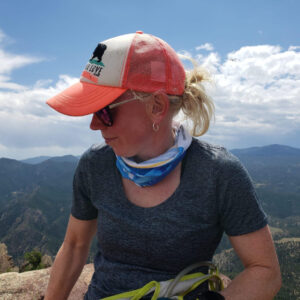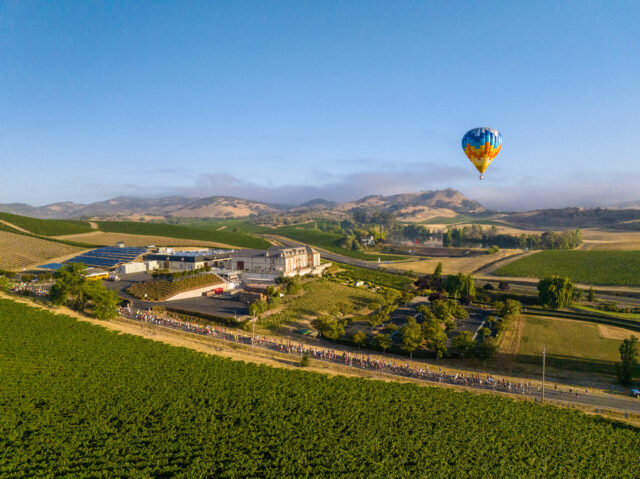Back in 1996, when Lyman Jordan, founder of Race Resources, wanted to create a race that would go between two metro stations about 10K apart outside D.C., the route he planned crossed through multiple towns and counties, involved transit agencies and police, and ultimately two him two years to get approved and established. “The traffic plan was 100 pages,” he said, and included 2,000 orange cones.
But now the Pikes Peek 10K is a popular race that’s been going every year since. It was worth the headache.
While many of the issues with creating a course are the same no matter how big or small your race is, once you start to crack 500 runners—and certainly by 1,000 athletes—the venues and hiccups change. Permitting, athlete flow, and traffic control become a larger part of the race director job. (That shifts again around 8,000-10,000 athletes, but extremely large races, like the New York Marathon, have entire staffs devoted to navigating red tape and calculating optimal athlete management flow.)
As your event grows from small to bigger, what do you need to consider in course creation and what do you need to change? What does getting a race course approved look like for medium-sized events?
The start and finish
Races are just like other sporting events, said Jim Gilmer, who helps RDs with course design and set-up, “but you build the stadium every time.” That means you have to construct the start and finish and course from scratch for each race, which presents unique challenges.
A good place to begin when creating a route, he said, is to decide where you want to start and finish. For larger races the start area is particularly important, because it determines the entire flow of the rest of your race.
Marcel Altenburg, a leading crowd scientist who consults with all the World Marathon Majors to individualize their athlete management, has used his research with the largest events to synthesize the findings into a few rules that also apply to small and medium-sized races. Two of those are that you want your start line to be about 30% narrower than the narrowest point in your race—especially important if a pinch point or turn comes in the first mile—and you want no more than three runners per square meter at the start (or one person takes up about two feet by two feet). (Altenburg covers more detail on the science of start line layout here.)
“The last time you can impact things is at the start,” said Altenburg, after that the runners are going to do whatever they need to or want to do—and you can’t control it as much.
That means it’s important to give yourself enough space at the beginning for runners to seed themselves by speed and to create a steady flow onto the course. Allowing for seeding, even in smaller races, is the most important thing for creating a good athlete flow and race experience, said Altenburg.
Build that start corral so that it works for you. Look at your carrying capacity and do the calculations. Then, consider where will you position pre-start port-a-potties and where will athletes warm-up.
The finish requires somewhat less math, but you still need to keep the flow moving so athletes don’t stop right at the line and create a backlog. Ideally, that flow will end the runners at the water and refreshments, said Gilmer.
Starting and finishing your race in roughly the same area decreases the logistical challenges of point-to-point courses—ie. shuttles and transportation—but if your race is large enough, then you likely don’t want them starting and finishing in exactly the same spot because it creates clogging and timing issues.
Designing a course
Most race directors have a rough route in mind or an idea (or had a route that worked but now have to adjust it for growing race fields), and then it’s a matter of finessing it with permitting officials and adjusting the start, finish, or turnarounds to get exactly the right mileage. What happens in between is up to you.
“Design it in a way that makes sense,” said Jordan. “Nature always sides with the hidden flaws.” What he means is as much as possible, keep it simple: make it one loop or a lollipop, no crossing back over the start line, minimal traffic interruptions by using smaller streets and avoiding large intersections or roadways where possible. If there’s a pinch point or a way runners can cut it short or get confused or run into each other, they will. Be clear about whether runners have the full use of the road or just one side or are contained to a coned off lane—this will be important when it comes to certification and accurate measurement.
“Some courses have a certain elegance of design to them,” said Gilmer. For instance, he prefers to put the harder parts in the middle of the race to allow for some strategy from athletes—and to not discourage them with big climbs right at the start or end.
You also have to keep in mind the positioning of port-a-potties, aid stations, and EMTs (or access for EMTs to get to the course if they need to).
The bigger the event, said Gilmer, the more important it is to have a specific person on staff whose job is to go through the course on race morning to ensure all the cones are in the right place, the turnarounds are where they’re supposed to be, and everything is set-up according to the race plan.
While smaller races can get away with using primarily parks and bike paths, that becomes nearly impossible for races over 500-1,000 people. Working with police, traffic agencies, and permitting authorities to shut down part or all of roadways is going to be extra important then.
Traffic and safety management
Because permitting is going to be such a big part of course creation for larger events, your first step should always be a visit to your local police department.
“Let them tell you what works,” said Gilmer, because they’ll have ideas and they’ll know what common issues come up. They’ll also be able to point you in the direction of whatever additional agencies need to permit your event, whether that’s the city or county or a park district or transit authority.
As you create preliminary maps, first using online mapping tools (but that’s not the final step!), you’ll want to stay in communication with the right person at each permitting agency, so you know what their concerns are and make sure you’re addressing them as you progress through the planning process: Are the roads fully or partially closed? Are you going to do a rolling closure of roads? How will you manage traffic and ensure the safety of the participants?
Once you have nearly finalized plans, you may have to present those to a city council, commission, or simply a city manager or traffic authority. It’s important to be prepared at this step. “You’re convincing them,” said Gilmer—so come with maps of the course, the start and finish areas, really draw out the details and pictures of where aid stations and traffic control will be places. “They know those streets inside out,” he said, but not for the purposes you want to use them for, so they’ll have questions and concerns. There may also be issues that come up at this point, like planned construction, which may require adjusting your route.
Then, it’s time to consider official measurement and certification.
Do you need your course to be certified?
Yes, it is a bit of a chicken-and-the-egg (read expert certifier Doug Thurston’s article for more insight): Most USATF certifiers won’t measure a course until the permits are in place, because they don’t want to have to do it again. But, of course, if the race route is measured and then needs to be adjusted slightly, you may have to go back to your permitting agency and adjust your plans. That’s why Jordan recommends when using MapMyRun or Strava to plot out your route to add in a little extra mileage, so that when it’s officially measured you’re more likely to have enough distance to get an accurate route.
The short explanation is that official USATF measurement has to go from point-to-point on the shortest possible route between the apex of turns, or via whatever dictates the course. Runners often do not follow that shortest route (which is why their GPS watch will read long!) and online tools similarly are not as accurate from point-to-point.
Measurement guarantees the official distance, and then certification is a little extra paperwork and about $50, said Jordan, to confirm to runners that your course is accurate.
(Because measure still requires a complicated manual process involving calibrating a tool and then riding a bike across the shortest line possible, it can be quite involved. You can find certified course measurers on USATF’s website.)
“I always recommend certification, except for the smallest events,” said Jordan.
It doesn’t necessarily matter until it does. Certification confirms to serious runners that your course is accurate and not randomly sketched out on someone’s Garmin watch, which could be more attractive for registration. And then if an age-group or national record is set at your event, certification also makes it eligible for record status (after verification). It might not be likely, but it’s possible and you don’t want that record to then not measure up.
About the Author
 Kelly O’Mara is the former editor-in-chief of Triathlete Magazine and the founder of the Triathlonish
Kelly O’Mara is the former editor-in-chief of Triathlete Magazine and the founder of the Triathlonish

